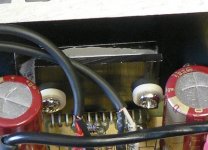
I finished my last LM4780 GC today.. Everything looks ok;
- Total 100mA quiescent current on both rails while muted or input shorted,
- (-)10mV (right) and (-)9mV (left) offsets on outputs and 5mV on inputs
and i havent connected any load or source until now. Because it gets hot as crazy. It increases up to 70°C in one minutes! For just first trying; i connected it to a little CPU heatsink without fan.
I checked every connections pin by pin but couldnt find any mistake.
Does anybody have any experience with LM4780s with little heatsink? And is this normal while inputs shorted?
PS: I know that , i asked a lot last days but i wouldnt ask if i dont need!
From my experiences, this is one hot running chip and not cool like the LM3875.
I had it attached to a 1.2C/W heatsink and with 35V rails was too hot. I ended up reducing the rails to 25V and all is cool.
From the Overture Design Guide (xls spreadsheet):
35V rails - 8R load 1.1C/W, 4R load 0.18C/W (chip can't use it)
30V rails - 8R load 1.76C/W, 4R load 0.53C/W (chip can't use it)
25V rails - 8R load 2.85C/W, 4R load 1.1C/W
I don't think the chip can utilise a heatsink greater than 1C/W and correct me if I'm wrong, but these have 2 LM3886's inside, so are going to be quite hot in use.
I'm sure the computer heatsink is way too small.
Hope this helps.
I had it attached to a 1.2C/W heatsink and with 35V rails was too hot. I ended up reducing the rails to 25V and all is cool.
From the Overture Design Guide (xls spreadsheet):
35V rails - 8R load 1.1C/W, 4R load 0.18C/W (chip can't use it)
30V rails - 8R load 1.76C/W, 4R load 0.53C/W (chip can't use it)
25V rails - 8R load 2.85C/W, 4R load 1.1C/W
I don't think the chip can utilise a heatsink greater than 1C/W and correct me if I'm wrong, but these have 2 LM3886's inside, so are going to be quite hot in use.
I'm sure the computer heatsink is way too small.
Hope this helps.
rabbitz said:
I don't think the chip can utilise a heatsink greater than 1C/W and correct me if I'm wrong, but these have 2 LM3886's inside, so are going to be quite hot in use.
I'm sure the computer heatsink is way too small.
You can download the inter-active design tool from National to determine the heat sink value --
http://www.national.com/appinfo/audio/files/Overture_Design_Guide15.xls For +/- 24 VDC with an 8 ohm load the thermal impedance should be 3.1 degrees per watt --
Here's how to determine the heat sink value -- get a 10 to 50 ohm power resistor -- the kind that you can screw onto a heat sink -- get a decent kitchen thermometer -- the metal kind from Williams Sonoma or Bed n Bath, or an electronic outdoor thermometer from RS -- you probably have one anyway -- I attach the heat sink to a string and suspend it from my adjacent work table so that it isn't in contact with any surface -- attach the thermometer to the heatsink -- measure the initial temperature , run an amp through the resistor and take the temperature of the heat sink in one hour -- this will give you the rise in temperature for the number of watts that the resistor has been baking at.
Dxvideo said:I dont worry about my heatsink. I will use a 0,4°C/W huge one.
The chip can't utilise the 0.4C/W heatsink as the LM4780 package can't transfer the heat quick enough..... about 1C/W heatsink max.
It's not an easy chip to mount securely as it has open holes on the ends so I used a clamp made from alumium. This also kept the mounting screws away from the body as when they touched, the chip was grounded to the heatsink.... not good..... see pic.
Attachments
rabbitz said:
The chip can't utilise the 0.4C/W heatsink as the LM4780 package can't transfer the heat quick enough..... about 1C/W heatsink max.
It's not an easy chip to mount securely as it has open holes on the ends so I used a clamp made from alumium. This also kept the mounting screws away from the body as when they touched, the chip was grounded to the heatsink.... not good..... see pic.
That's incorrect.
jackinnj said:
That's incorrect.
That's what I was getting with the Overture Design Guide spreadsheet.... oh well, so much for National's design guides [in the bin].
rabbitz said:
That's what I was getting with the Overture Design Guide spreadsheet.... oh well, so much for National's design guides [in the bin].
No, the lower the thermal impedance (C/W) the more efficient the heat sink is at removing energy -- the heat sink can't go any lower than the ambient (room) temperature unless you blow cold (refrigerated) air through it, or a cold liquid.
The problem you can run into with a very large heat sink is that if you can get carried away with your experimentation -- you can drive the rail voltages pretty darn high and cause the chip to thermally cycle -- by this time you may violate the boundary conditions for the semiconductor devices on the chip anyway. Bindardundat.
- Status
- This old topic is closed. If you want to reopen this topic, contact a moderator using the "Report Post" button.
- Home
- Amplifiers
- Chip Amps
- LM4780 is burning!
